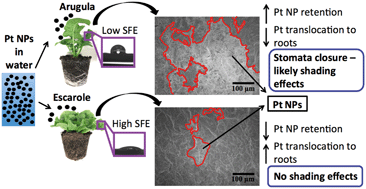当前位置:
X-MOL 学术
›
Environ. Sci.: Nano
›
论文详情
Our official English website, www.x-mol.net, welcomes your feedback! (Note: you will need to create a separate account there.)
Foliar surface free energy affects platinum nanoparticle adhesion, uptake, and translocation from leaves to roots in arugula and escarole†
Environmental Science: Nano ( IF 7.3 ) Pub Date : 2017-12-19 00:00:00 , DOI: 10.1039/c7en00887b Eva Kranjc 1, 2, 3, 4, 5 , Darja Mazej 2, 3, 5, 6 , Marjana Regvar 2, 3, 7, 8, 9 , Damjana Drobne 2, 3, 7, 8, 9 , Maja Remškar 2, 3, 4, 5
Environmental Science: Nano ( IF 7.3 ) Pub Date : 2017-12-19 00:00:00 , DOI: 10.1039/c7en00887b Eva Kranjc 1, 2, 3, 4, 5 , Darja Mazej 2, 3, 5, 6 , Marjana Regvar 2, 3, 7, 8, 9 , Damjana Drobne 2, 3, 7, 8, 9 , Maja Remškar 2, 3, 4, 5
Affiliation

|
Pt nanoparticles (NPs) are directly emitted into air from human activities, contributing to the pollutant load of plants and posing risks to food safety. Foliar surface characteristics affect particle interception and retention from air; however the influence of foliar surface free energy (SFE), a quantitative measure of polar and dispersive surface forces which determine hydrophobicity/hydrophilicity, has not been investigated. Here, soil-grown plantlet leaves of arugula (low SFE) and escarole (high SFE) were exposed to Pt NPs (5–500 mg Pt NPs per L) for 5 days. Pt NP internalization and translocation, aggregation/agglomeration on leaf surfaces, and SFE changes were analyzed. Plantlets were also root-exposed to Pt NPs (one exposure to 20 mL of 50 mg L−1 dispersion) to provide a comparison between leaf-to-root and root-to-leaf translocation. Among foliar-exposed plants, inductively coupled plasma-mass spectrometry data showed that relative to escarole, arugula contained higher Pt concentrations in leaves (33, 31, and 14 times higher for 5, 50, and 500 mg L−1 exposures, respectively) and lower Pt concentrations in roots (6, 4, and 3 times lower for 5, 50, and 500 mg L−1 exposures, respectively). For both plants, the proportion of Pt translocated from roots to leaves (99% and 28% for arugula and escarole, respectively) was higher than that from leaves to roots (<1% for both plants). Scanning electron micrographs of foliar-exposed leaves (500 mg Pt NPs per L) showed a much higher degree of Pt NP aggregation/agglomeration on arugula relative to escarole, in addition to stomata closure from likely shading effects on arugula. Analysis of foliar SFE results based on acid–base theory did not indicate any relationship between Pt NP exposure and changes to SFE. We conclude that plants with low SFE are significantly more likely to adhere and retain NPs than plants with high SFE, providing implications for the application of nanopesticides, where NP adsorption and retention are of interest, and for food safety, where the presence of NPs should be minimized.
中文翻译:

叶表面自由能影响铂纳米颗粒的粘附,摄取以及从叶到芝麻菜和e菜籽中的根的转移†
Pt纳米颗粒(NPs)通过人类活动直接排放到空气中,导致植物的污染物负荷增加,并给食品安全带来风险。叶的表面特性影响空气中颗粒的拦截和滞留。然而,尚未研究叶表面自由能(SFE)的影响,叶表面自由能(SFE)是确定疏水性/亲水性的极性和分散表面力的定量度量。在这里,将芝麻菜(低SFE)和大黄酮(高SFE)的土壤小植株叶片暴露于Pt NPs(每升5-500 mg Pt NPs)5天。分析了Pt NP的内在化和易位,叶表面的聚集/附聚以及SFE的变化。幼苗也根暴露于Pt NPs(一次暴露于20 mL的50 mg L -1分散性)以提供叶到根和根到叶易位之间的比较。在暴露于叶面的植物中,电感耦合等离子体质谱法数据显示,相对于e菜油,芝麻菜的叶片中Pt浓度更高(分别暴露于5、50和500 mg L -1时,其Pt浓度分别高33、31和14倍)降低根中的Pt浓度(5、50和500 mg L -1分别降低6、4和3倍)曝光)。对于这两种植物,Pt从根到叶的转运比例(分别为99%和28%的芝麻菜和大黄酮)高于从叶到根的转运(两种植物的含量均<1%)。暴露于叶的叶片的扫描电子显微镜照片(每升500 mg Pt NPs)显示,与芝麻菜油相比,芝麻菜上的Pt NP聚集/团聚程度要高得多,此外还有可能受到对芝麻菜的遮光作用而导致的气孔关闭。基于酸碱理论对叶面SFE结果的分析表明,Pt NP暴露与SFE变化之间没有任何关系。我们得出的结论是,低SFE的植物比高SFE的植物更有可能粘附和保留NP,这为纳米农药的应用带来了影响,因为纳米农药对NP的吸附和保留至关重要,并且对食品安全性具有重要意义。
更新日期:2017-12-19
中文翻译:

叶表面自由能影响铂纳米颗粒的粘附,摄取以及从叶到芝麻菜和e菜籽中的根的转移†
Pt纳米颗粒(NPs)通过人类活动直接排放到空气中,导致植物的污染物负荷增加,并给食品安全带来风险。叶的表面特性影响空气中颗粒的拦截和滞留。然而,尚未研究叶表面自由能(SFE)的影响,叶表面自由能(SFE)是确定疏水性/亲水性的极性和分散表面力的定量度量。在这里,将芝麻菜(低SFE)和大黄酮(高SFE)的土壤小植株叶片暴露于Pt NPs(每升5-500 mg Pt NPs)5天。分析了Pt NP的内在化和易位,叶表面的聚集/附聚以及SFE的变化。幼苗也根暴露于Pt NPs(一次暴露于20 mL的50 mg L -1分散性)以提供叶到根和根到叶易位之间的比较。在暴露于叶面的植物中,电感耦合等离子体质谱法数据显示,相对于e菜油,芝麻菜的叶片中Pt浓度更高(分别暴露于5、50和500 mg L -1时,其Pt浓度分别高33、31和14倍)降低根中的Pt浓度(5、50和500 mg L -1分别降低6、4和3倍)曝光)。对于这两种植物,Pt从根到叶的转运比例(分别为99%和28%的芝麻菜和大黄酮)高于从叶到根的转运(两种植物的含量均<1%)。暴露于叶的叶片的扫描电子显微镜照片(每升500 mg Pt NPs)显示,与芝麻菜油相比,芝麻菜上的Pt NP聚集/团聚程度要高得多,此外还有可能受到对芝麻菜的遮光作用而导致的气孔关闭。基于酸碱理论对叶面SFE结果的分析表明,Pt NP暴露与SFE变化之间没有任何关系。我们得出的结论是,低SFE的植物比高SFE的植物更有可能粘附和保留NP,这为纳米农药的应用带来了影响,因为纳米农药对NP的吸附和保留至关重要,并且对食品安全性具有重要意义。



























 京公网安备 11010802027423号
京公网安备 11010802027423号